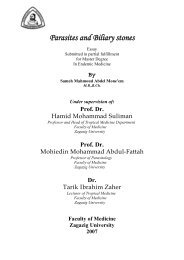E. Coli
E. Coli
E. Coli
Create successful ePaper yourself
Turn your PDF publications into a flip-book with our unique Google optimized e-Paper software.
6- Urease test<br />
The test determine the ability of bacteria to decompose urea by means<br />
of urease enzyme. The development of red colour indicates hydrolysis of<br />
urea.<br />
7- Sugar fermentation test<br />
The isolated organisms were cultured into sugar media containing 1%<br />
of the tested sugar. Phenol red act as indicator. Yellow colour indicate acid<br />
production while gas production seen in Durham’s tubes, after incubation<br />
at 37°C for 1-7 days.<br />
3.2.4. Serological identification of E.coli :<br />
Serological analysis was performed according to methods described by<br />
Edwards and Ewing(1972).<br />
1- O antigen group screening:<br />
a-Slide agglutination test:<br />
A glass pencil was used to divide a glass slide into 2 parts, one drop of<br />
the polyvalent sera and one drop of the polyvalent sera and one drop of the<br />
physiological saline were separately placed in the 2 section.<br />
Each isolate was densely suspended in physiological saline. One<br />
drop of the suspension, using the platinum loop, was placed in each<br />
separate section of the slides in the vicinity of polyvalent sera and<br />
physiological saline. The antigen and the serum drop were mixed in each<br />
section.<br />
The glass slides were titled back and front only strong agglutinations<br />
occurring within one minute were accepted as positive, when positive<br />
reaction was observed with one of the polyvalent sera, slide agglutination<br />
40
















